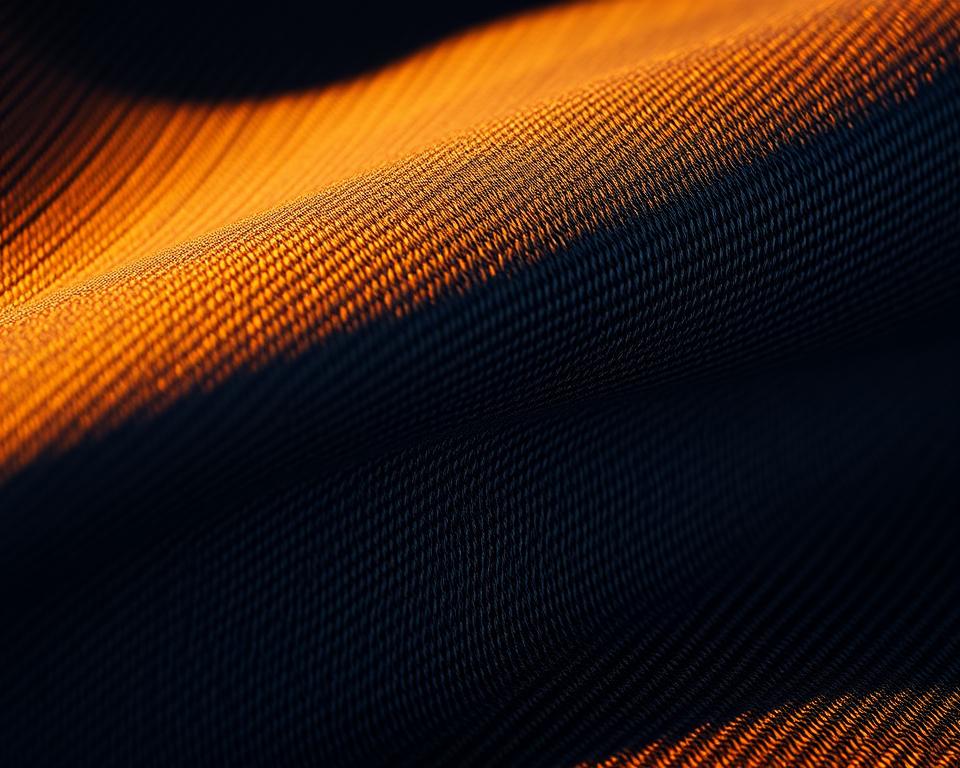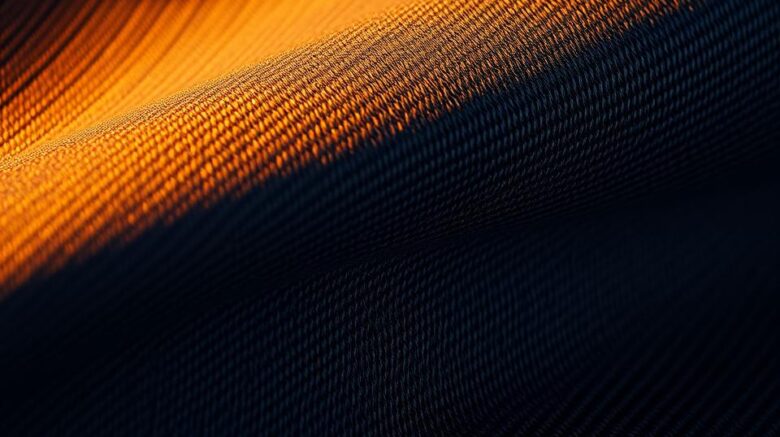Your Manual for Premium denim Edge-to-Edge Material
Have you ever pondered the reason certain pants seem as though they are designed for longevity a lifetime? The secret lies in the elements and artistry. For example, the increasing movement of high-end selvedge. This goes beyond common textile—it attests to quality and tradition.
Today, a growing number of people are opting for these timeless textiles for their sturdiness and classic selvedge denim fabric appeal. Whether you’re a home sewing sewist or a denim aficionado, there’s an exceptional aspect about using high-quality cotton and yarn. It isn’t solely concerned with making jeans; it centers on producing a narrative.
Within Core Fabrics, we’ve curated a selection of 14.25oz organic cotton and flexible variants. These materials are tailor-made for a spectrum ranging from raw trousers to couture jacket blueprints. Prepared to dive into the realm of exceptional fabrics? Let us delve in.
What Is Denim Selvedge Fabric?
What is it that makes some trousers stand out with their unique, self-finished borders? The key is found in the selvedge denim, a high-quality material celebrated for its durability and old-school charm. Unlike regular textiles, this type of fabric is fashioned with classic methods that have proven their worth.
Understanding Selvedge Denim
Selvedge denim is produced using vintage shuttle looms, which yield minimal widths of about 30-35 inches. They intertwine the fabric in a manner that ensures self-finished borders, often accented with a signature red line. This method confirms the material is firmly crafted and exceptionally sturdy.
Contemporary looms, in contrast, generate expansive material but fall short of the equivalent of artistry. Minor flaws in selvedge, like twists in the leg or irregular surfaces, are celebrated as features of its character. This approach, often referred to as “wabi-sabi”, exalts the appeal of organic flaws.
How Selvedge Denim Is Made
The production of selvedge denim requires a meticulous process. These looms cross the filling yarns in alternating directions, creating a compact and sturdy textile. This method contrasts with modern looms, which emphasize speed and efficiency over craftsmanship.
Labels such as Karson Denim preserve traditional Japanese craft practices from the nineteen-nineties. They purposefully add imperfections to preserve the true character of the textile. Every item is evaluated on a 4-point system, confirming it meets the peak requirements of excellence.
| Feature | Selvedge Denim | Contemporary Denim |
|---|---|---|
| Span | 30-35 inches | 60+ inches |
| Fabrication Method | Traditional Shuttle | New-Age Loom |
| Finish | Uneven, Imperfect | Even |
| Durability | Superior | Standard |
“The charm of selvedge resides in its natural irregularities—each irregularity speaks of skill and legacy.”
The Legacy of Selvedge Denim
Evolving from simple roots to global acclaim, the story of these fabrics is vibrant and moving. Originally developed as hardwearing clothing in seventeenth-century France has become a signifier of timeless style and craftsmanship.
Historical Roots
The roots of this textile dates back to Nîmes, France, where it was known as “serge de Nîmes.” Initially created for workers, it was constructed with sturdy cotton and yarn. Its resilience rendered it beloved among laborers during the Gold Rush.
By the 20th century, it had become a essential element for pants. The ending of the Cone Mills White Oak plant marked a turning point. This change enabled Japanese artisans to revive classic fabric-making practices.

Modern Developments in Denim
After World War II, Japan embraced old-school American culture. Skilled workers repaired old looms to manufacture true reproductions. This commitment to artistry guaranteed the survival of selvedge as a unique product.
Today, breakthroughs from Italy and Turkey have launched eco-friendly combinations and elastic variants. These improvements have widened the allure of this timeless textile. At Core Fabrics, we procure internationally, from Montréal to Asia, to offer you the top-notch quality.
“The legacy of selvedge is a testament to the lasting worth of craftsmanship and legacy.”
The Benefits of Selvedge Denim?
Why does selvedge denim distinguish itself in the realm of top-tier textiles? Its special characteristics and exceptional longevity have made it beloved among lovers and designers alike. Be it that you are crafting trousers or a tailored jacket, this fabric delivers a blend of classic methods and updated style.
Distinctive Attributes of Selvedge
Selvedge denim is renowned for its dense construction, which enhances tear resistance and wear patterns. Differing from regular textiles, selvedge denim material is crafted using traditional shuttle looms, yielding a denser and exceptionally sturdy material. Such a process guarantees that all products boast a distinct surface and character.
Notable attributes are:
- Hairy, rigid raw denim contrasts with laundered, relaxed stretch options.
- The sanforization process ensures predictable sizing, while untreated fabrics provide a dynamic fitting process.
- Available weights span from 9.5oz Eco Finish to 14.25oz Organic, meeting varied requirements.
Sturdiness and Lifespan
One of the most remarkable aspects of selvedge denim is its enduring nature. The dense fabric structure both reinforces strength and permits unique fading patterns over time. This makes it a treasured choice for those in pursuit of classic garments.
Key points to consider:
- 12-14oz weights are ideal for structured jackets and jeans that soften with age.
- For classic jean longevity, the 14.25oz True Indigo is a top recommendation.
- Sustainable variants such as recycled cotton combined with indigo blends enhance eco-friendliness.
Within our range at Core Fabrics, diverse choices cater to distinct demands. From raw to sanforized, each piece is crafted to deliver exceptional quality and value.
Selvedge vs. Wide Denim: A Comparison
When it comes to crafting robust and fashionable apparel, the decision of textile plays a crucial role. Two popular options are selvedge and wide denim, both offering different features. Knowing how they differ assists in selecting the best option for your project.
Distinct Weaving Methods
Selvedge denim is woven on classic shuttle looms, yielding slim widths of 30-35 inches. This striped selvedge denim fabric technique creates firm borders, often accented with a distinctive red line. Conversely, wide denim employs advanced projectile looms, yielding expansive widths of over 60 inches.
Traditional shuttle looms operate at approximately 3 meters per minute, while contemporary projectile looms achieve up to 30m per minute. Such speed differences influence both the price and the finish of the final product.
Pros and Cons of Each Type
Selvedge denim is known for its premium quality and durability. Its narrow width renders it perfect for applications where exposed edges or decorative patches are required. However, it can be costlier, typically around $23 per meter.
Wide denim is more cost-effective, ranging at $8 per half-meter. Its wider width minimizes excess, making it suitable for large projects like furniture covering. However, it falls short of the signature finished border of selvedge.
| Attribute | Selvedge Denim | Wide Denim |
|---|---|---|
| Span | 30-35 inches | 60+ inches |
| Technique | Classic Shuttle Loom | Projectile Loom |
| Production Speed | 3m/min | 30m per minute |
| Cost | $23/meter | $8/half-meter |
For structured edges, like those needed in Grainline Thayer jackets, selvedge is the preferred choice. In contrast, wide denim provides cost-effectiveness and speedy production. Consider your project needs to make the best decision.
Maximizing Your Selvedge Denim
Crafting with high-end textiles raises your projects to a new standard. Whether you are creating jeans, blazers, or dresses, understanding the basics of yardage, sewing techniques, and care ensures a professional finish. Let’s delve into ways to best utilize this everlasting textile.
Yardage Needed for Jeans and Jackets
It is essential to compute the correct fabric amount when designing your creation. For men’s jeans, you’ll need about 3-3.3 yards, accounting for potential defects and shrinkage. Trucker-style jackets generally demand about 3.3 yards, while a skirt often needs 2 yards.
Smart pattern positioning minimizes the impact of defects. Embrace the natural defects by weaving them into your creative design.
| Item | Yardage Needed |
|---|---|
| Jeans for Men | 3–3.3 yards |
| Trucker Jacket | 3.3 yards |
| Skirt | 2 yards |
Sewing Techniques and Maintenance
The correct gear and skills secure a refined outcome. Opt for #70 to 110 needle sizes and foot accessories designed for heavy materials. For contrast stitching, Gütermann rPET thread is a reliable choice.
Additional advice includes:
- Employ a tailor’s clapper to achieve crisp creases without gloss.
- Core Fabrics’ denim kits include topstitch thread, rivets, and 9mm jeans buttons for a professional finish.
- For structured edges, like those in jackets, selvedge is the preferred choice.
Proper care extends the life of your creations. Wash sparingly and air dry to maintain the material’s integrity. Adhering to these practices will sustain your creations for years.
As a Final Point
Crafting with premium materials isn’t just about durability—it’s about creating something with character. Selvedge denim embodies this ideology, merging craftsman allure with enduring excellence. Be it crafting jeans or tailoring a refined jacket, each stitch narrates a tale.
With Core Fabrics, unleashing your creative potential is effortless. Our swatch service lets you touch and test the fabric before deciding. Furthermore, take advantage of free shipping for orders above $150 USD in North America.
Future trends in cotton textiles include sustainable blends and retro washes. Such innovations provide novel methods for infusing eco-consciousness and fashion into your closet.
Ready to dive into the world of premium materials? Shop now and discover the value of crafting with purpose. Your future project might just be that lasting masterpiece.
